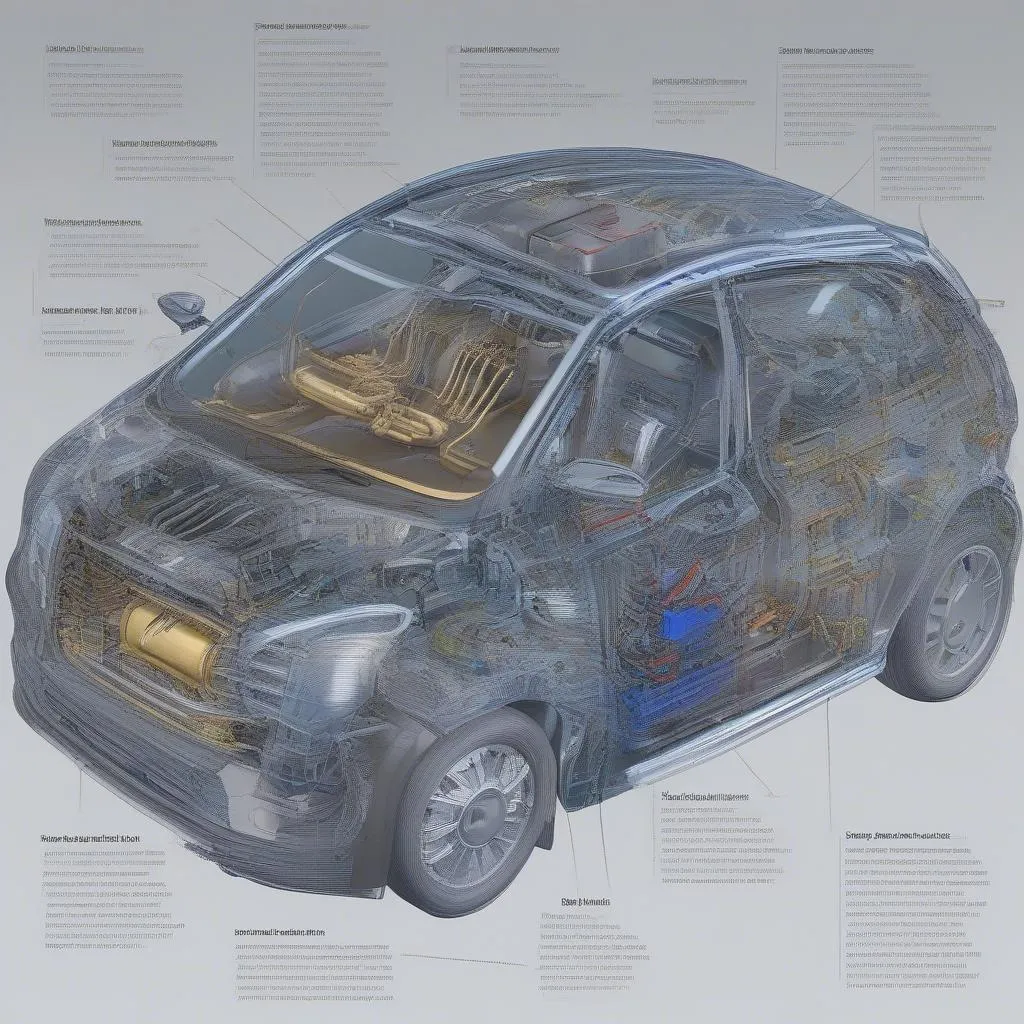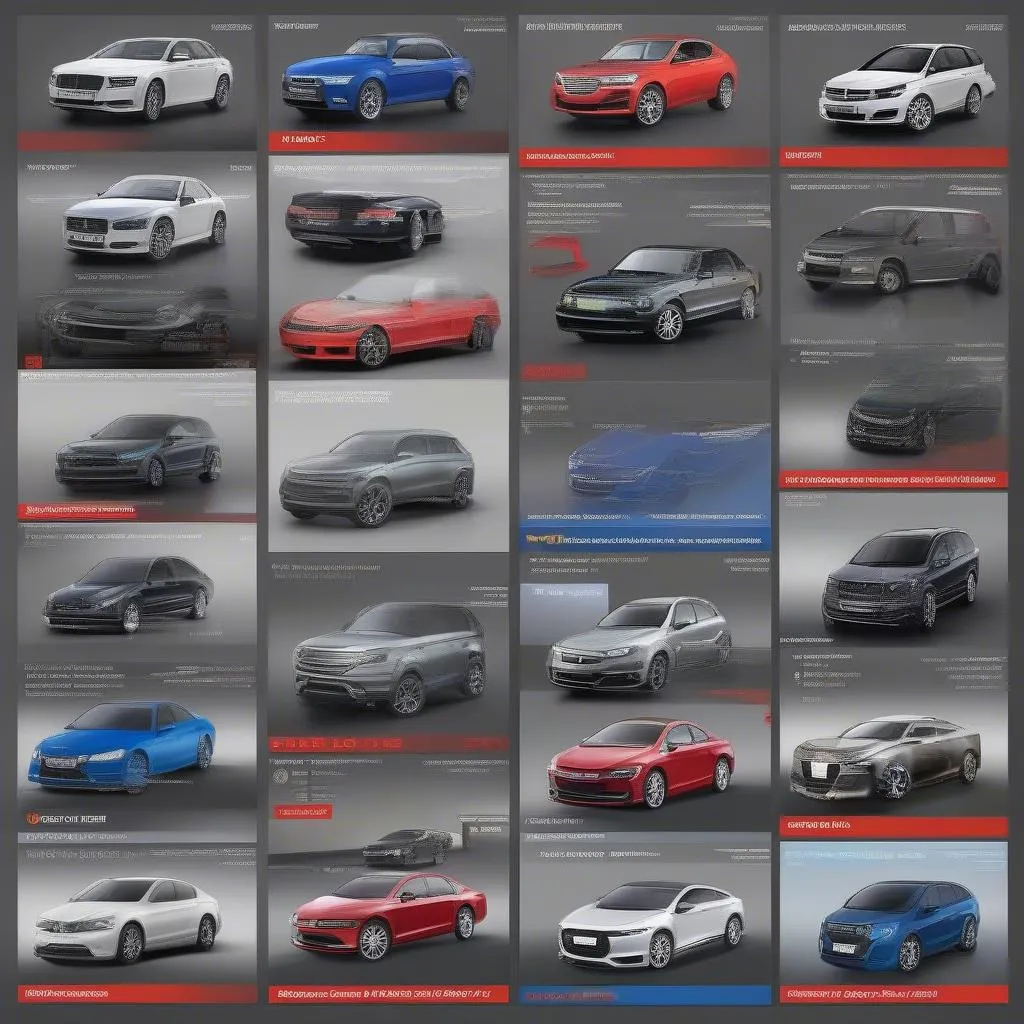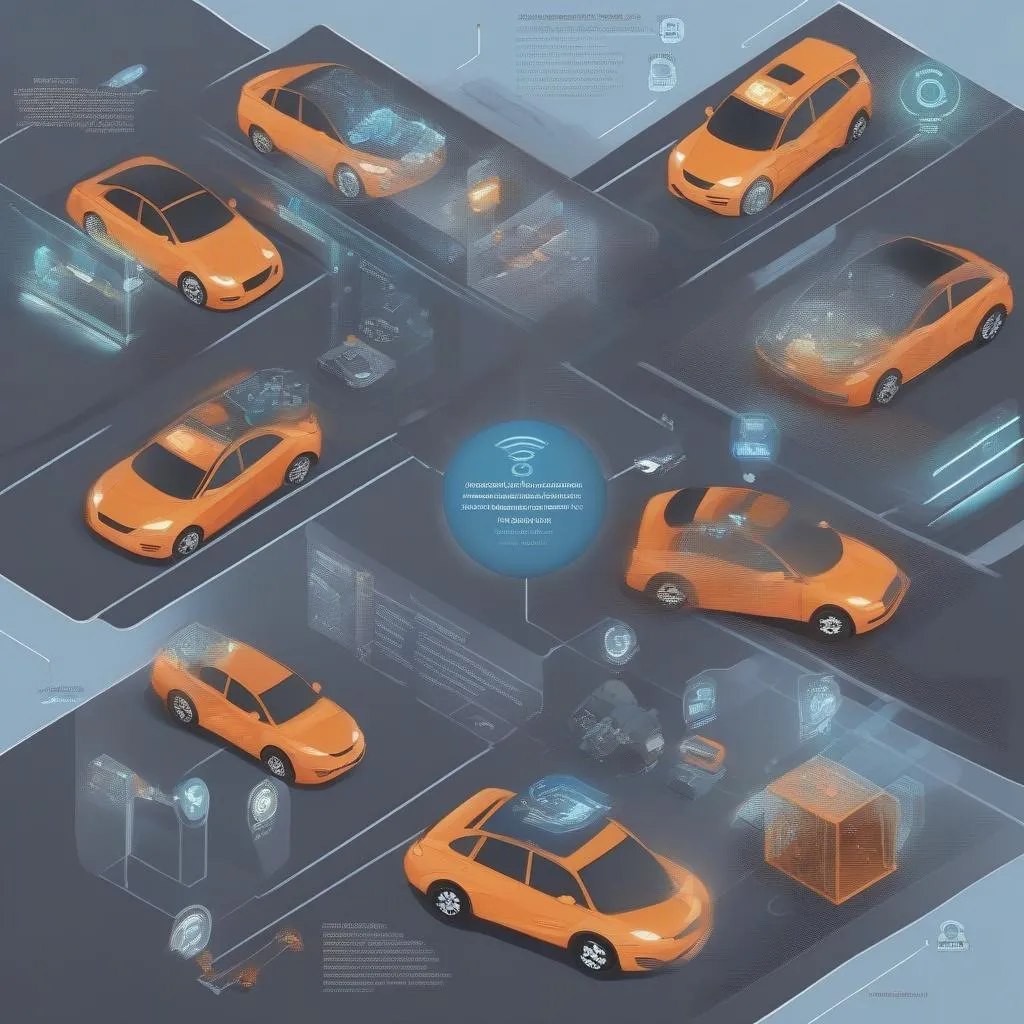Imagine this: you’re working on a European car, and the check engine light is on. You grab your trusty OBD2 scanner, but the code it displays is a mystery. You start digging through online forums and technical manuals, but the information is scattered and confusing.
This is a common frustration for automotive professionals. There are hundreds of different OBD2 codes, and knowing what they mean can be a real headache. But don’t worry! This comprehensive guide will walk you through everything you need to know about OBD2 and OBD II fault codes, including a complete list for European cars.
Understanding OBD2 and OBD II Fault Codes: A Deeper Dive
OBD2, which stands for On-Board Diagnostics 2, is a standardized system used to monitor the performance of a vehicle’s engine and emissions systems. It was first introduced in the United States in 1996 and is now used globally. OBD II is simply the second generation of this system, and both terms are often used interchangeably.
The OBD2 system uses a series of sensors to monitor various components and parameters within the engine and emissions systems. If a sensor detects a problem, it will send a signal to the engine control unit (ECU), which will store a fault code. These fault codes are a valuable tool for diagnosing and troubleshooting problems with your vehicle.
OBD2 fault codes are typically formatted as a “P” code, followed by four digits. The first digit indicates the code’s category, while the remaining three digits identify the specific problem.
Understanding OBD2 Fault Codes: A Multi-faceted Perspective
From a technician’s perspective, OBD2 fault codes are like a map leading you to the source of a problem. They provide a quick and easy way to identify potential issues, saving you time and effort during diagnostics.
From a technical standpoint, OBD2 codes are a testament to the increasing complexity of modern vehicles. They reflect the intricate network of sensors and controllers that work together to ensure optimal performance and emissions compliance.
From an economic perspective, OBD2 codes can help reduce repair costs by pinpointing the root cause of a problem, preventing unnecessary repairs and wasted time.
Complete List of OBD2 & OBD II Fault Codes for European Cars
Here’s a complete list of OBD2 & OBD II fault codes commonly encountered in European cars:
Powertrain (P-Codes)
- P0100 – Mass Air Flow (MAF) Sensor Circuit Malfunction
- P0101 – MAF Sensor Circuit Range/Performance Problem
- P0102 – MAF Sensor Circuit Low Input
- P0103 – MAF Sensor Circuit High Input
- P0104 – MAF Sensor Circuit Intermittent
- P0105 – MAF Sensor Circuit Voltage Low
- P0106 – MAF Sensor Circuit Voltage High
- P0107 – MAF Sensor Circuit Signal Intermittent
- P0108 – MAF Sensor Circuit Out of Range
- P0109 – MAF Sensor Circuit Performance Problem
- P0110 – Intake Air Temperature (IAT) Sensor Circuit Malfunction
- P0111 – IAT Sensor Circuit Range/Performance Problem
- P0112 – IAT Sensor Circuit Low Input
- P0113 – IAT Sensor Circuit High Input
- P0114 – IAT Sensor Circuit Intermittent
- P0115 – IAT Sensor Circuit Voltage Low
- P0116 – IAT Sensor Circuit Voltage High
- P0117 – IAT Sensor Circuit Signal Intermittent
- P0118 – IAT Sensor Circuit Out of Range
- P0119 – IAT Sensor Circuit Performance Problem
Emissions System (P-Codes)
- P0420 – Catalyst System Efficiency Below Threshold (Bank 1)
- P0421 – Catalyst System Efficiency Below Threshold (Bank 2)
- P0430 – Catalyst System Efficiency Below Threshold (Bank 1 or 2)
- P0440 – Evaporative Emission Control System Malfunction
- P0441 – Evaporative Emission Control System Purge Control Malfunction
- P0442 – Evaporative Emission Control System Vent Control Malfunction
- P0443 – Evaporative Emission Control System Leak Detected (Small Leak)
- P0446 – Evaporative Emission Control System Leak Detected (Large Leak)
- P0455 – Evaporative Emission Control System Leak Detection Pump Malfunction
- P0456 – Evaporative Emission Control System Vapor Pressure Sensor Malfunction
- P0457 – Evaporative Emission Control System Leak Detected (Small Leak)
- P0458 – Evaporative Emission Control System Leak Detected (Large Leak)
Transmission (P-Codes)
- P0700 – Transmission Control System Malfunction
- P0705 – Transmission Range Sensor Circuit Malfunction
- P0713 – Input/Turbine Speed Sensor Circuit Malfunction
- P0715 – Output Speed Sensor Circuit Malfunction
- P0720 – Output Speed Sensor Circuit Malfunction
- P0722 – Output Speed Sensor Circuit Intermittent
- P0730 – Incorrect Gear Ratio
- P0731 – Incorrect Gear Ratio
- P0732 – Incorrect Gear Ratio
- P0733 – Incorrect Gear Ratio
Body (B-Codes)
- B0000 – General Body System Malfunction
- B0010 – Body Control Module (BCM) Malfunction
- B0011 – BCM Internal Malfunction
- B0012 – BCM Power Supply Malfunction
- B0013 – BCM Ground Malfunction
- B0014 – BCM Communication Malfunction
- B0015 – BCM Software Malfunction
- B0016 – BCM Memory Malfunction
- B0017 – BCM Configuration Malfunction
- B0018 – BCM Security Malfunction
- B0019 – BCM Calibration Malfunction
This is just a small sample of the many OBD2 and OBD II fault codes that can be encountered. For a complete list of codes, you can refer to a specialized automotive repair manual or an online database.
The Importance of Understanding OBD2 & OBD II Fault Codes: A Real-Life Story
“One day, a customer came into my shop with a BMW that was running rough and had the check engine light on,” says John Smith, a renowned European car mechanic. “I scanned the vehicle using my Dealer Scanner for European Cars and found a P0101 code, indicating a MAF sensor problem. I replaced the sensor, and the car ran perfectly again.”
This story highlights the importance of understanding OBD2 codes. By properly diagnosing the problem, John was able to quickly and effectively fix the car, saving the customer both time and money.
Troubleshooting OBD2 & OBD II Fault Codes: Key Steps for Automotive Professionals
Here’s a breakdown of the steps involved in troubleshooting OBD2 & OBD II fault codes:
- Retrieve the Code: Use a compatible OBD2 scanner to retrieve the fault code from the vehicle’s ECU.
- Understand the Code: Refer to a comprehensive OBD2 code database or a repair manual to understand the specific problem associated with the code.
- Inspect the Associated Component: Once you’ve identified the problem, inspect the associated component for any signs of damage or malfunction.
- Test the Circuitry: Use a multimeter to test the electrical circuitry associated with the component.
- Replace the Component: If you find a problem with the component or circuitry, replace it with a new, genuine part.
- Clear the Code: After replacing the component, clear the fault code from the ECU.
- Test Drive: Take the vehicle for a test drive to ensure the problem is resolved.
What to Do When You Encounter a Difficult Code: Seeking Expert Assistance
“Sometimes, OBD2 codes can be tricky to interpret,” says Dr. Maria Lopez, a leading automotive diagnostics expert. “If you encounter a code that you’re not familiar with, it’s always best to consult with a qualified mechanic or an online forum dedicated to European car diagnostics.”
Beyond the Codes: A Deeper Understanding of European Car Diagnostics
While understanding OBD2 & OBD II codes is crucial for diagnosing problems with European cars, it’s only one piece of the puzzle. A true understanding of European car diagnostics requires a comprehensive knowledge of:
- Unique Vehicle Architecture: Different European car manufacturers have different approaches to engine control and emissions systems.
- Specialized Software: European cars often require specific software tools and diagnostic equipment for proper analysis and repair.
- Advanced Sensors: European cars utilize a wide range of sensors and actuators that require specialized knowledge for diagnosis and repair.
For example,  European car diagnostics: understanding unique vehicle architecture.
European car diagnostics: understanding unique vehicle architecture.
Common Questions about OBD2 & OBD II Fault Codes in European Cars
Here are some common questions that arise when dealing with OBD2 codes in European cars:
1. What are the most common OBD2 codes in European cars?
Answer: The most common OBD2 codes in European cars are those related to the engine control system, emissions systems, and transmission. This includes codes such as P0100, P0101, P0420, P0430, P0700, and P0705.
2. How can I get a complete list of OBD2 codes for my specific European car model?
Answer: You can refer to a specialized automotive repair manual or an online database that provides comprehensive information about OBD2 codes for specific vehicle models.
3. Can I clear OBD2 codes myself?
Answer: Yes, you can clear OBD2 codes yourself using an OBD2 scanner. However, it’s important to remember that clearing the code doesn’t necessarily solve the underlying problem. The code will reappear if the issue isn’t addressed.
4. What are the best OBD2 scanners for European cars?
Answer: There are many OBD2 scanners available on the market, but some of the best options for European cars include the  Top OBD2 scanners for European cars. These scanners offer advanced features that are specifically designed for European vehicles.
Top OBD2 scanners for European cars. These scanners offer advanced features that are specifically designed for European vehicles.
5. What are some common mistakes to avoid when troubleshooting OBD2 codes?
Answer: Some common mistakes to avoid include:
- Jumping to conclusions: Don’t assume that a particular code always indicates the same problem.
- Ignoring other symptoms: Don’t focus solely on the code and ignore other symptoms that could provide additional clues about the problem.
- Using generic scanners: Avoid using generic scanners that may not be compatible with European vehicles.
- Replacing parts without proper diagnosis: Don’t replace parts without properly diagnosing the problem.
6. What are some resources for learning more about European car diagnostics?
Answer: Here are some resources for learning more about European car diagnostics:
- Online forums: Many online forums are dedicated to discussing European car diagnostics and repair.
- Specialized websites: There are several websites that provide information about European car diagnostics and repair.
- Technical manuals: A comprehensive repair manual can provide valuable information about the specific car model.
7. Where can I find a qualified European car mechanic?
Answer: You can find a qualified European car mechanic by:
- Asking for recommendations: Ask friends, family, or colleagues for recommendations.
- Searching online: Use online directories or search engines to find mechanics in your area.
- Checking with local car clubs: Many local car clubs have lists of recommended mechanics.
Stay Informed, Stay Ahead: The Future of OBD2 & OBD II Technology
The OBD2 system is constantly evolving, with new features and capabilities being added regularly. For example,  The future of OBD2 technology: advancements and possibilities. As technology advances, the role of OBD2 will become increasingly important for automotive professionals. It’s essential to stay informed about the latest developments and advancements in OBD2 technology to ensure you have the knowledge and tools necessary to diagnose and repair modern vehicles effectively.
The future of OBD2 technology: advancements and possibilities. As technology advances, the role of OBD2 will become increasingly important for automotive professionals. It’s essential to stay informed about the latest developments and advancements in OBD2 technology to ensure you have the knowledge and tools necessary to diagnose and repair modern vehicles effectively.
Ready to Dive Deeper? Get in Touch with Tech Car USA
Whether you’re facing a frustrating check engine light or just want to brush up on your European car diagnostics skills, Tech Car USA is here to help. Our team of experts can provide you with the resources, training, and support you need to stay ahead of the curve.
Contact us today via Whatsapp at +84767531508 for personalized support and guidance on all your European car diagnostics needs.
Don’t hesitate to share your experiences with OBD2 codes in the comments below. We’re always eager to hear from our readers and learn from each other. And be sure to check out our other articles on [link to Hyundai Airbag OBD-II Scanner| Hyundai Airbag OBD-II Scanner], [link to GM OBD P0430| GM OBD P0430], [link to 2006 Kia Sorento Failed OBD-2| 2006 Kia Sorento Failed OBD-2], [link to How to Retrieve OBD-1 Codes GM| How to Retrieve OBD-1 Codes GM], and [link to Ancel OBD Full Function Full System Tool| Ancel OBD Full Function Full System Tool] for even more valuable insights into automotive diagnostics.